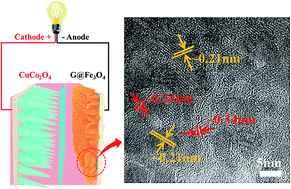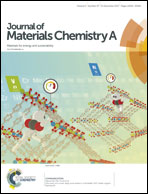In situ encapsulated Fe3O4 nanosheet arrays with graphene layers as an anode for high-performance asymmetric supercapacitors†
Abstract
Energy density of asymmetric supercapacitors (ASCs) is greatly limited by the electrochemical performance, especially low specific capacitance and poor cycling stability, of anode materials. To achieve high-performance ASCs, herein, we designed and synthesized a new anode material of Fe3O4 nanosheet arrays, which were encapsulated in situ by graphene layers (G@Fe3O4) through plasma enhanced chemical vapor deposition. Vertical-standing G@Fe3O4 nanosheet arrays directly on the conductive substrates can facilitate electrolyte diffusion and reduce the internal resistance. Furthermore, the highly conductive graphene layers in situ encapsulating the Fe3O4 nanosheets not only could provide fast ion and electron transport pathways, but could also maintain a stable structure for G@Fe3O4. When used as electrodes, G@Fe3O4 exhibited highest capacitance (up to 732 F g−1), better rate capability, and cycling stability as compared to pristine Fe3O4. Furthermore, an asymmetric supercapacitor device synthesized using G@Fe3O4 as an anode and CuCo2O4 as the cathode showed a high energy density of up to 82.8 W h kg−1 at a power density of 2047 W kg−1 and good cycling stability (88.3% capacitance after 10 000 cycles).



 Please wait while we load your content...
Please wait while we load your content...